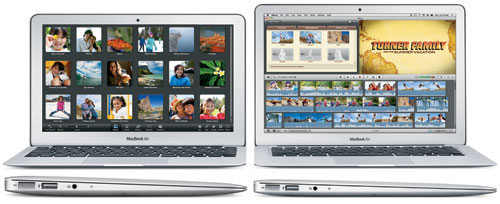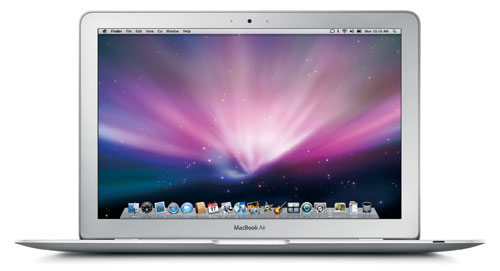Hosted by site sponsor WebMate.
MacBook Air Q&A
Published November 14, 2010
All Mac Q&As >> MacBook Air Q&A (Home) | Also See: All MacBook Air Specs
To be notified of new Q&As, sign up for EveryMac.com's bimonthly email list.
What are the differences between the "Late 2010" MacBook Air models and the "Mid-2009" MacBook Air models that they replaced?
Please note that all notebooks mentioned in this Q&A have been discontinued. However, this Q&A is up-to-date and quite useful for anyone buying or selling one on these models on the used market.
The differences between the "Late 2010" MacBook Air models -- the MacBook Air "Core 2 Duo" 1.4 11-Inch (Late 2010) and "Core 2 Duo" 1.86 13-Inch (Late 2010) -- and the "Mid-2009" MacBook Air models that they replaced -- the MacBook Air "Core 2 Duo" 1.86 13-Inch (Mid-2009) and "Core 2 Duo" 2.13 13-Inch (Mid-2009) -- are substantial.
The immediately obvious difference is that the "Late 2010" MacBook Air series introduces an 11-Inch model in addition to a 13-Inch model, whereas previous MacBook Air notebooks only were available with 13-Inch displays. However, there are other technological and product positioning differences just about as significant.

Photo Credit: Apple, Inc. (Left - 11" Right - 13" "Late 2010" MacBook Air)
External Differences
All MacBook Air models have extremely thin all aluminum cases, but the "Late 2010" MacBook Air models are even a little bit thinner than their predecessors -- 0.11 of an inch at the front and 0.68 of an inch at the rear compared to 0.16 of an inch at the front and 0.76 of an inch at the rear for the "Mid-2009" MacBook Air models. The "Late 2010" MacBook Air models weigh a bit less as well -- 2.3 pounds for the 11-Inch model and 2.9 pounds for the 13-Inch model compared to 3.0 pounds for the 13-Inch "Mid-2009" models.

Photo Credit: Apple, Inc. ("Mid-2009" MacBook Air)
In a major difference, both "Late 2010" models have displays that are high-resolution for their physical dimensions -- 1366x768 for the 11-Inch and 1440x900 for the 13-Inch -- whereas the "Mid-2009" models have 13-Inch displays with a 1280x800 native resolution.
All MacBook Air models have a "full size" keyboard that essentially is the same "chiclet" keyboard used by all previous MacBook and MacBook Pro models. However, possibly due to space constraints, the "Late 2010" models have a keyboard that is not backlit, whereas the "Mid-2009" models have a backlit keyboard. The "Late 2010" 11-Inch model also has smaller function keys with the power key integrated into the same row to save space.
Trackpads provided by each line are considerably different. The "Mid-2009" models have a single-button "three-finger" multitouch gesture trackpad whereas the "Late 2010" models have have glass "no button" trackpads with "inertial scrolling" support.
Both lines have integrated webcams, although Apple refers to the webcam in the "Mid-2009" models as an "iSight" camera and the webcam in the "Late 2010" models as a "FaceTime" camera. Branding aside, the cameras are believed to be identical. Audio is considerably better with the "Late 2010" models as they have integrated stereo speakers whereas earlier MacBook Air models only have a mono speaker.
Connectivity Differences
Connectivity is improved by the "Late 2010" MacBook Air models as well. Both lines have AirPort Extreme (802.11a/b/g/n), Bluetooth 2.1+EDR, analog audio out, and a Mini DisplayPort that supports an external 30-Inch display (2560x1600) as well as built-in internal microphones. However, the "Late 2010" MacBook Air models have dual USB 2.0 ports rather than just one and the 13-Inch "Late 2010" model additionally has an integrated SD Card slot. None of these models have Firewire, optical audio in/out, or Ethernet, although an external 10/100Base-T Ethernet adapter is available (standard on the "Mid-2009" models and a US$29 extra for the "Late 2010"). None support a remote via IR, either.
Identification Differences
The "Late 2010" MacBook Air models have model numbers that were unique when they were released -- specifically A1370 for the 11-Inch model and A1369 for the 13-Inch model. By contrast, the "Mid-2009" MacBook Air is model number A1304, which it also shares with the "Late 2008" line.
However, as none of these model numbers are unique, the EMC numbers are better for more precise identification of the "Late 2010" line. Specifically, these EMC numbers are 2393 and 2392, for the 11-Inch and 13-Inch models, respectively. Consequently, EveryMac.com has painstakingly hand documented these details for your convenience.
In software, the "Late 2010" models also can be pinpointed by model identifier, and use MacBookAir3,1 for the 11-Inch model and MacBookAir3,2 for the 13-Inch model.
Unfortunately, the "Mid-2009" MacBook Air does not have an externally listed EMC number, and it shares its model identifier with the earlier "Late 2008" line (MacBookAir2,1), so it only can be externally identified by its serial number using EveryMac.com's Ultimate Mac Lookup feature. EveryMac.com's Ultimate Mac Lookup also can uniquely identify the "Late 2010" MacBook Air models by their serial numbers.
Internal, Configuration & Pricing Differences
Internally, there are some similarities between these lines, but major differences, too. All models are powered by Core 2 Duo processors of varying speeds and have 2 GB of memory onboard by default, but the "Late 2010" models can be upgraded to 4 GB as a US$100 option at the time of purchase. The 13-Inch models all have 6 MB on chip level 2 caches and a 1066 MHz system bus, but the 11-Inch "Late 2010" model only has 3 MB of on chip level 2 cache and a 800 MHz system bus. The "Mid-2009" models have NVIDIA GeForce 9400M graphics and the "Late 2010" models have faster NVIDIA GeForce 320M graphics but both share 256 MB of RAM with the system.
Perhaps most notably in terms of technology, however, the "Late 2010" models are only available with Mini-SATA connected flash memory for storage that is not intended to be upgraded whereas the "Mid-2009" models were offered with either a hard drive or a Serial ATA-connected flash-based SSD.
Battery life additionally is improved with the 13-Inch "Late 2010" model and is estimated to provide 7 hours of runtime compared to 5 hours for its predecessor and the 11-Inch "Late 2010" model.
Perhaps even more important than the technological differences is that the "Late 2010" models are sold at lower price points with the 11-Inch model hitting the psychologically crucial US$999 price point, and this in all likelihood will have a major impact on sales for the MacBook Air.
Comparison Chart
The differences between the "Late 2010" and "Mid-2009" MacBook Air models -- size, display size, connectivity, battery life, processor, technical architecture, configuration and price -- are summarized below:
 Mid-2009 13" |
 Late 2010 11" |
 Late 2010 13" |
|
|---|---|---|---|
| Processor Speed: | 1.86, 2.13 GHz | 1.4 GHz* | 1.86 GHz** |
| Processor Type: | SL9400, SL9600 | SU9400* | SL9400** |
| On-Chip L2 Cache: | 6 MB | 3 MB | 6 MB |
| System Bus: | 1066 MHz | 800 MHz | 1066 MHz |
| Standard RAM: | 2 GB | 2 GB | 2 GB |
| Maximum RAM: | 2 GB | 4 GB† | 4 GB† |
| Internal Storage: | 120 GB, 128 GB | 64 GB, 128 GB | 128 GB, 256 GB |
| Storage Type: | Hard Drive, SSD | SSD | SSD |
| Internal Video: | GeForce 9400M | GeForce 320M | GeForce 320M |
| USB 2.0 Ports: | 1 | 2 | 2 |
| Ethernet Adapter: | Included | US$29 | US$29 |
| SD Card Slot: | No | No | Yes |
| Display Size: | 13.3" Widescreen | 11.6" Widescreen | 13.3" Widescreen |
| Display Resolution: | 1280x800 | 1366x768 | 1440x900 |
| Backlit Keyboard: | Yes | No | No |
| Trackpad: | 3-Finger | Inertial | Inertial |
| Speakers: | Mono | Stereo | Stereo |
| Battery Life: | 5 Hours | 5 Hours | 7 Hours |
| Dimensions: | .16-.76 x 12.8 x 8.94 | .11-.68 x 11.8 x 7.56 | .11-.68 x 12.8 x 8.94 |
| Weight: | 3.0 Pounds | 2.3 Pounds | 2.9 Pounds |
| Order Numbers: | MC233LL/A MC234LL/A |
MC505LL/A MC506LL/A |
MC503LL/A MC504LL/A |
| Model Numbers: | A1304 | A1370 | A1369 |
| Model Identifier: | MacBookAir2,1 | MacBookAir3,1 | MacBookAir3,2 |
| Intro Price: | US$1499, US$1799 | US$999, US$1199 | US$1299, US$1599 |
* The MC506LL/A configuration of the 11-Inch "Late 2010" model, which has 128 GB of storage, can be upgraded to a 1.6 GHz Core 2 Duo (SU9600) processor as a US$100 option at the time of purchase.
** The MC504LL/A configuration of the 13-Inch "Late 2010" model, which has 256 GB of storage, can be upgraded to a 2.13 GHz Core 2 Duo (SL9600) processor as a US$100 option at the time of purchase.
† Either "Late 2010" model can be upgraded to 4 GB of RAM at the time of purchase. This RAM is soldered in place and cannot be upgraded after purchase.
Used MacBook Air Purchase & Sale Options
There are any number of places to purchase a "Mid-2009" or "Late 2010" MacBook Air on the used market. However, purchasing from a quality seller with extensive experience in the Mac market -- and after sales support -- will provide the best experience and save you money and time, too.
In the US, site sponsor Other World Computing sells used and refurb MacBook Air models at bargain prices with free shipping, as well. On the other hand, if you need to sell a MacBook Air, A+ BBB-rated Cash for Your Mac and GoRoostr will buy your older notebook with an instant quote and prompt payment.
In the UK, site sponsor Hoxton Macs sells used MacBook Air models with a one-year warranty and free next day delivery throughout the UK. Delivery across Europe also is available starting at just £9.99 for two-day delivery to France and Germany.
Please refer to EveryMac.com's Ultimate Mac Comparison feature to dynamically compare any MacBook Air model to any other G3 or later Mac.
Also see: How fast are the "Late 2010" MacBook Air models compared to one another and to earlier MacBook Air models? How fast are these models compared to the "Mid-2010" MacBook and MacBook Pro models?
Permalink | Report an Error/Typo | Sign Up for Site Update Notices
Established in 1996, EveryMac.com has been created by experts with decades of experience with Apple hardware. EveryMac.com includes, and always has included, original research incorporating detailed, hands-on inspection of packaging, computers, and devices as well as extensive real-world use. All information is provided in good faith, but no website or person is perfect. Accordingly, EveryMac.com is provided "as is" without warranty of any kind whatsoever. EveryMac.com, and the authors thereof, shall not be held responsible or liable, under any circumstances, for any damages resulting from the use or inability to use the information within. For complete disclaimer and copyright information please read and understand the Terms of Use and the Privacy Policy before using EveryMac.com. Copying, scraping, or use of any content without expressed permission is not allowed, although links to any page are welcomed and appreciated.
